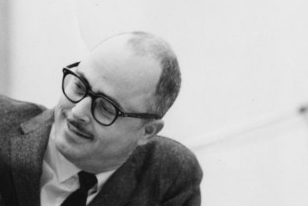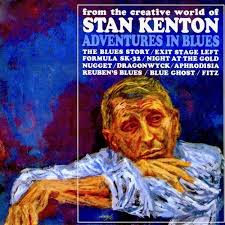Exit Stage Left – Gene Roland
A medium swinger with a very simple riff head, written for Stan Kenton's big band. In addition to a Concert Condensed Score, we have "thread" parts available which show the main melodic line running through the arrangement. Both contain transcriptions of Gene Roland's mellophone solo.
- Recording: Stan Kenton - Adventures In Blues
- Recorded on: December 7, 1961
- Label: Capitol (ST 1985)
- Concert Key: C
- Vocal Range: , to
- Style: Swing (medium)
- Trumpet - Dalton Smith, Marvin Stamm, Norman Baltazar, Bob Rolfe, Bob Behrendt
- Mellophone - Gene Roland, Ray Starling, Dwight Carver, Keith LaMotte, Carl Saunders
- Trombone - Bob Fitzpatrick, Bud Parker, Dee Barton
- Bass Trombone - Jim Amlotte, Dave Wheeler
- Alto Sax - Gabe Baltazar
- Tenor Sax - Buddy Arnold, Paul Renzi
- Bari Sax - Allan Beutler
- Bass Sax - Joel Kaye
- Bass - Pat Senatore
- Drums - Jerry Lestock McKenzie
Purchase Exit Stage Left - Gene Roland
Purchasing this song through our affiliate links with certain retailers provides jazzleadsheets.com with additional support to help keep us bringing you the best lead sheets available. Thank you!
Video
- Description
- Historical Notes
- Solos
- Piano Corner
- Bass Corner
- Drum Corner
- Guitar Corner
- Inside & Beyond
- Minus You
Gene Roland really finessed the challenge of arranging for a big band with an additional section of instruments, the mellophones; far from being cluttered or chaotic, everything is very clearly laid out in his writing. His approach to form is full of subtle surprises.Exit Stage Left begins with three A sections instead of the expected two, to build up three layers of counterpoint. First the saxes play the melody riff with the rhythm section; in the second A the trombones add figures that fill in around the melody. The third A section introduces the mellophones, which augment the texture with harmonies that float in the background. Two measures of drum solo are added at the end of this section to lead into the bridge, which is dominated by the brass. The C section ("last A") reverses the counterpoint from the previous sections, with mellophones on the melody answered by the saxes playing what was previously the trombones' figure. A break at the end of this section launches Gene's mellophone solo. The second chorus is split between mellophone and alto sax solos, with backgrounds all based on the melody. After the solos the key modulates to F for a shout chorus, with trumpet and trombone figures answered by the mellophones; each of the two phrases of this section are extended to ten measures with a rising pyramid that crescendos to the next section. Four measures of bass solo then lead back to the key of C for two more A sections, arranged the same as the second and first A sections of the in head. These are followed by a four-measure drum solo which builds back up to another shout section, again in F, with a stop-time tag that winds down with a muted trumpet solo fill at the end.
Our Concert Condensed Score shows the lead lines of all important figures. It contains a transcription of Gene's mellophone solo up to the second A section, where muted trumpet backgrounds come in. Our thread parts have the main melodic lines further condensed into a single line almost throughout, with counterpoint only in the shout sections, and consolidated into a playable range. They contain a complete transcription of Gene's solo.
More songs from "Adventure In Blues."
Related Songs
Email Send Exit Stage Left to a friend

Gene Roland
September 15, 1921 – August 11, 1982
The only composer with the distinction of working for Stan Kenton for all four decades of Kenton’s band’s existence, Gene Roland was born in Dallas, Texas, and began studying the piano at age eleven. Over the course of his career, he mastered many instruments, from trombone to trumpet to mellophonium to drums, but his real success came through his talent as an arranger and composer. Read more...

